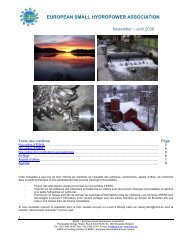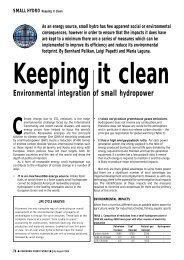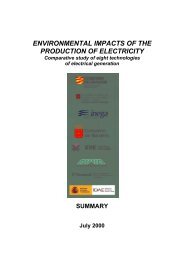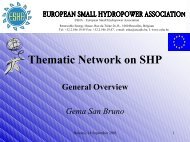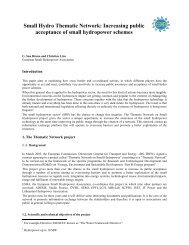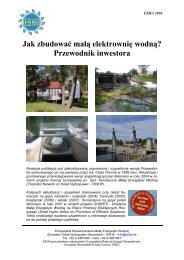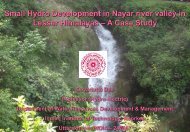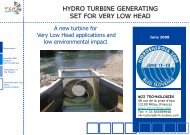HYDROPOWER AND ENVIRONMENT - ESHA
HYDROPOWER AND ENVIRONMENT - ESHA
HYDROPOWER AND ENVIRONMENT - ESHA
You also want an ePaper? Increase the reach of your titles
YUMPU automatically turns print PDFs into web optimized ePapers that Google loves.
MITIGATION MEASURES<br />
2.5<br />
FISH-FRIENDLY TURBINES<br />
When fi sh are going downstream in a river, they may<br />
get into the headrace channel and risk dying when<br />
passing through the turbine. The survival of a turbine-passed<br />
fi sh is highly dependent on the path the<br />
fi sh takes; usually the main damaging zones are the<br />
ones shown later in the fi gure, which correspond to<br />
specifi c injury mechanisms: increasing pressure (1),<br />
rapidly decreasing pressure (2), cavitation (3), strike<br />
(4), grinding (5), shear (6) and turbulence (7).<br />
Different types of equipment like strobe lights for repelling<br />
fi sh, mercury lights for attracting fi sh, sound<br />
generating devices and electrical guidance systems<br />
Source: U.S. Department<br />
of Energy<br />
FISH DAMAGING ZONES<br />
PAST LEARNING<br />
can keep fi sh away from passing the trash rack, but it<br />
has not yet been demonstrated that these measures<br />
can be directed reliably. So, many studies are now<br />
developing new hydropower turbine designs that<br />
would minimize fi sh injury and mortality, by simulating<br />
turbine hydraulics in the laboratory coupled with<br />
using fi sh species of interest for testing and by reefing<br />
the conceptual design with the use of the Computational<br />
Fluid Dynamics (CFD) simulations.<br />
Otherwise, in the SHP fi eld, there are a lot of applications,<br />
such as low head and extreme low head,<br />
where the installation of conventional turbines may<br />
The EPRI study (1992) fi ndings showed that estimated<br />
mortality averaged 20% for Francis turbines, 12% for<br />
Kaplan turbines, and 9% for bulb turbines<br />
18<br />
be economically unsuitable. Instead of them, the<br />
widespread choices are the classical water wheels,<br />
built traditionally from wood or recently from steel, or<br />
the “inverted” Archimedean screw. They do not need<br />
a fi ne trash rack, are robust in operation and, above<br />
all, are fi sh-friendly, thanks to their much slower rotation<br />
velocity. So, by learning from the past it could be<br />
possible to improve the future.<br />
EXAMPLE: THE ARCHIMEDEAN SCREW<br />
Source: RITZ-ATRO<br />
The Archimedean screw is over 2000 years old, and<br />
has traditionally been used for pumping. Only recently<br />
it has been used in applications for generating<br />
electricity at low-head hydro sites too: this special<br />
turbine consists of an Archimedean screw operating<br />
in reverse, so that the falling water turns the screw,<br />
which itself in turn drives a generator.<br />
ADVANTAGES:<br />
high effi ciency maintained over a wide<br />
range of fl ows;<br />
no fi ne screening required;<br />
very good fi sh compatibility.<br />
“The hydraulic screw shows a high level of compatibility<br />
with fi sh and it is well suited to facilitating fi sh descent”.<br />
(Fishery Biological Opinion on the Fish Compatibility<br />
of the Patented Hydrodynamic Screw by Dr Späh



